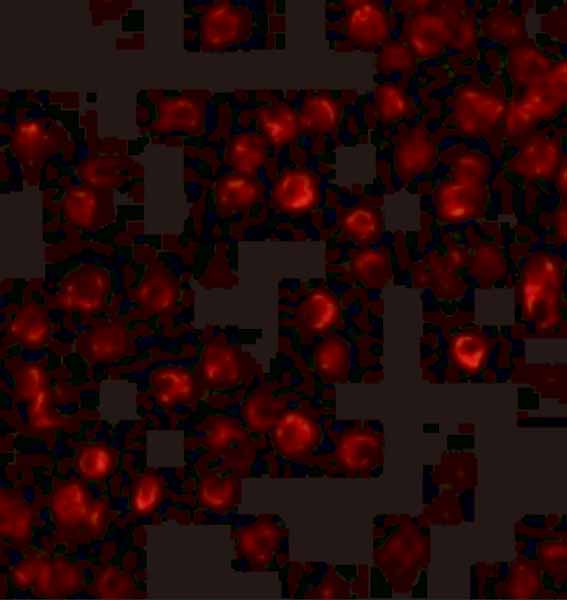TRPC3 Antibody
- SPECIFICATION
- CITATIONS
- PROTOCOLS
- BACKGROUND

Application
| WB, IHC-P, E |
|---|---|
| Primary Accession | Q13507 |
| Other Accession | CAA74083, 7222 |
| Reactivity | Human |
| Host | Rabbit |
| Clonality | Polyclonal |
| Isotype | IgG |
| Calculated MW | Predicted: 93 kDa Observed: 100 kDa |
| Application Notes | TRPC3 antibody can be used for the detection of TRPC3 by Western blot at 1 - 2 μg/mL. Antibody can also be used for immunohistochemistry starting at 10 μg/mL. |
| Gene ID | 7222 |
|---|---|
| Other Names | TRPC3 Antibody: TRP3, TRP3, Short transient receptor potential channel 3, Transient receptor protein 3, TrpC3, transient receptor potential cation channel, subfamily C, member 3 |
| Target/Specificity | TRPC3 antibody was raised against a 14 amino acid synthetic peptide from near the amino terminus of human TRPC3. The immunogen is located within amino acids 120 - 170 of TRPC3. |
| Reconstitution & Storage | TRPC3 antibody can be stored at 4℃ for three months and -20℃, stable for up to one year. As with all antibodies care should be taken to avoid repeated freeze thaw cycles. Antibodies should not be exposed to prolonged high temperatures. |
| Precautions | TRPC3 Antibody is for research use only and not for use in diagnostic or therapeutic procedures. |
| Name | TRPC3 |
|---|---|
| Synonyms | TRP3 |
| Function | Forms a receptor-activated non-selective calcium permeant cation channel (PubMed:8646775, PubMed:9417057, PubMed:9930701, PubMed:20095964, PubMed:30139744, PubMed:29726814, PubMed:35051376). May be operated by a phosphatidylinositol second messenger system activated by receptor tyrosine kinases or G-protein coupled receptors (PubMed:8646775). |
| Cellular Location | Cell membrane; Multi-pass membrane protein |
| Tissue Location | Expressed predominantly in brain and at much lower levels in ovary, colon, small intestine, lung, prostate, placenta and testis |

Thousands of laboratories across the world have published research that depended on the performance of antibodies from Abcepta to advance their research. Check out links to articles that cite our products in major peer-reviewed journals, organized by research category.
info@abcepta.com, and receive a free "I Love Antibodies" mug.
Provided below are standard protocols that you may find useful for product applications.
Background
TRPC3 Antibody: The mammalian transient receptor potential (TRP) superfamily can be divided into three major families including the "canonical TRP" (TRPC) family. The seven members of this family share the activation through PLC-coupled receptors and have been suggested to be components of receptor-regulated cation channels in different cell types. Furthermore, the members of the TRPC3/6/7 subfamily can be activated by diacylglycerol analogs, suggesting a possible mechanism of activation of these channels by PLC-coupled receptors. TRPC3 encodes a Ca2+-permeant channel that is agonist-activated but not store-operated or directly receptor-activated. TRPC3 physically interacts with TRPC6 and TRPC7 and forms functional tetrameric channels.
References
Contell C, Birnbaumer V, Flockerzi V, et al. A unified nomenclature for the superfamily of TRP cation channels. Mol. Cell 2002; 9:229-31.
Trebak M, Vazquez G, Bird GSJ, et al. The TRPC3/6/7 subfamily of cation channels. Cell Calcium 2003; 33:451-61.
Zitt C, Obukhov AG, Strubing C, et al. Expression of TRPC3 in Chinese hamster ovary cells results in calcium-activated cation currents not related to store depletion. J. Cell. Biol. 1997; 1333-41.
If you have used an Abcepta product and would like to share how it has performed, please click on the "Submit Review" button and provide the requested information. Our staff will examine and post your review and contact you if needed.
If you have any additional inquiries please email technical services at tech@abcepta.com.













 Foundational characteristics of cancer include proliferation, angiogenesis, migration, evasion of apoptosis, and cellular immortality. Find key markers for these cellular processes and antibodies to detect them.
Foundational characteristics of cancer include proliferation, angiogenesis, migration, evasion of apoptosis, and cellular immortality. Find key markers for these cellular processes and antibodies to detect them. The SUMOplot™ Analysis Program predicts and scores sumoylation sites in your protein. SUMOylation is a post-translational modification involved in various cellular processes, such as nuclear-cytosolic transport, transcriptional regulation, apoptosis, protein stability, response to stress, and progression through the cell cycle.
The SUMOplot™ Analysis Program predicts and scores sumoylation sites in your protein. SUMOylation is a post-translational modification involved in various cellular processes, such as nuclear-cytosolic transport, transcriptional regulation, apoptosis, protein stability, response to stress, and progression through the cell cycle. The Autophagy Receptor Motif Plotter predicts and scores autophagy receptor binding sites in your protein. Identifying proteins connected to this pathway is critical to understanding the role of autophagy in physiological as well as pathological processes such as development, differentiation, neurodegenerative diseases, stress, infection, and cancer.
The Autophagy Receptor Motif Plotter predicts and scores autophagy receptor binding sites in your protein. Identifying proteins connected to this pathway is critical to understanding the role of autophagy in physiological as well as pathological processes such as development, differentiation, neurodegenerative diseases, stress, infection, and cancer.


